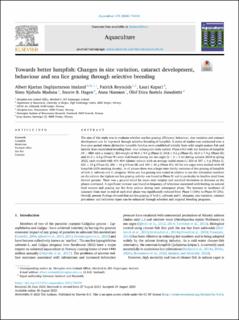| dc.contributor.author | Imsland, Albert | |
| dc.contributor.author | Reynolds, Patrick | |
| dc.contributor.author | Kapari, Lauri Teemu | |
| dc.contributor.author | Maduna, Simo | |
| dc.contributor.author | Hagen, Snorre | |
| dc.contributor.author | Hanssen, Anne | |
| dc.contributor.author | Jónsdóttir, Ólöf Dóra Bartels | |
| dc.date.accessioned | 2023-10-05T08:00:25Z | |
| dc.date.available | 2023-10-05T08:00:25Z | |
| dc.date.created | 2023-09-25T16:00:22Z | |
| dc.date.issued | 2023-09-05 | |
| dc.identifier.citation | Imsland, A. K. D., Reynolds, P., Kapari, L., Maduna, S. N., Hagen, S. B., Hanssen, A., & Jónsdóttir, Ó. D. B. (2024). Towards better lumpfish: Changes in size variation, cataract development, behaviour and sea lice grazing through selective breeding. Aquaculture, 578, 740041. | en_US |
| dc.identifier.issn | 0044-8486 | |
| dc.identifier.uri | https://hdl.handle.net/11250/3094356 | |
| dc.description.abstract | The aim of this study was to evaluate whether sea lice grazing efficiency, behaviour, size variation and cataract development can be improved through selective breeding of lumpfish. A series of studies was conducted over a four-year period where distinctive lumpfish families were established initially from wild caught mature fish and latterly from established breeding lines. Four subsequent trials (called: Phase I-IV) with ten families of lumpfish (N = 480) with a mean (± SD) weight of 46.4 ± 9.4 g (Phase I), 54.8 ± 9.2 g (Phase II), 42.0 ± 7.4 g (Phase III) and 31.3 ± 2.4 g (Phase IV) were distributed among ten sea cages (5 × 5 × 5 m) during autumn 2018 to spring 2022, each stocked with 400–404 Atlantic salmon with an average initial mean (± SD) of 387 ± 9 g (Phase I), 621 ± 15 g (Phase II), 280 ± 16 g (Phase III) and 480 ± 66 g (Phase IV). All the ten cages were stocked with 48 lumpfish (12% stocking density). In all phases there was a large inter-family variation of lice grazing of lumpfish of both L. salmonis and C. elongatus. When sea lice grazing was scaled in relation to sea lice infestation numbers on the salmon the highest sea lice grazing activity was found in Phase IV and in particular in families sired from farmed parents. There was a general trend for mean start weights and standard deviations to decrease as the phases continued. A significant increase was found in frequency of behaviour associated with feeding on natural food sources and grazing sea lice from salmon during each subsequent phase. The increase in incidence of cataracts from start to end of each trial phase was significantly reduced from Phase I (16%) to Phase IV (2%). Overall, present findings showed that sea lice grazing of both L. salmonis and C. elongatus, size variation, cataract prevalence and behaviour types can be enhanced through selection and targeted breeding programs. | en_US |
| dc.language.iso | eng | en_US |
| dc.publisher | Elsevier B.V. | en_US |
| dc.rights | Navngivelse 4.0 Internasjonal | * |
| dc.rights.uri | http://creativecommons.org/licenses/by/4.0/deed.no | * |
| dc.title | Towards better lumpfish: Changes in size variation, cataract development, behaviour and sea lice grazing through selective breeding | en_US |
| dc.title.alternative | Towards better lumpfish: Changes in size variation, cataract development, behaviour and sea lice grazing through selective breeding | en_US |
| dc.type | Peer reviewed | en_US |
| dc.type | Journal article | en_US |
| dc.description.version | publishedVersion | en_US |
| dc.rights.holder | © 2023 The Authors | en_US |
| dc.source.volume | 578 | en_US |
| dc.source.journal | Aquaculture | en_US |
| dc.identifier.doi | 10.1016/j.aquaculture.2023.740041 | |
| dc.identifier.cristin | 2178691 | |
| dc.relation.project | Norges forskningsråd: 282460 | en_US |
| dc.source.articlenumber | 740041 | en_US |
| cristin.ispublished | true | |
| cristin.fulltext | original | |
| cristin.qualitycode | 2 | |

